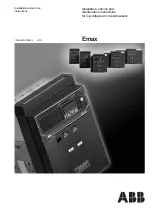
55
IZM32 / IN32 low voltage air circuit breaker
MN013017EN May 2022 www.eaton.com
Section 8: Troubleshooting
Section 8: Troubleshooting
8-1 Introduction
Table 8.1 will help to determine the probable causes of simple circuit breaker problems and possible corrective actions.
Possible problems associated with the electronic trip unit are covered in PXR20/25 instructions manual. If the problem cannot
be resolved with the aid of one or both of these guides, contact the Eaton service center for more in-depth assistance.
Table 8.1 Circuit breaker troubleshooting guide.
Symptom
Probable cause
Corrective actions
The circuit breaker trips open (red
fault trip indicator buttonis out and/
or fault indicator LED is lighted)
when closed on a load current
Rating plug not installed and load current through the
breaker
Install rating plug that corresponds to current sensors
Repeated closing on transient (in-rush) current with
thermal memory active
Wait for circuit breaker (and loads) to cool before
re-closing
An overload or fault current condition
Use status and fault indicators to help locate and remove
overload or fault condition
Circuit breaker opens (fault trip
indicator button is not out)
Undervoltage release operates; voltage too low or
zero
Check and correct the UVR supply voltage (85–110%
rated voltage)
Shunt trip operates
Check control signal(s) to shunt trip; correct if necessary
Trip latch is defective
Inspect latch condition and engagement before closing;
consult Eaton service center
Circuit breaker cannot be opened
remotely, but can be opened locally
Shunt trip control signal absent or too low
Check supply voltage exceeds 70% of rated voltage
when signal is applied to shunt trip
Shunt trip is faulty or improperly installed
Remove front cover; check voltage supplied to shunt trip;
make sure shunt trip is seated and retainer snapped into
place. Check for shunt trip motion; replace shunt trip if
faulty
Secondary contact wiring problem
Make sure electrical pin and socket connectors are
properly seated in molded plug. Verify proper wiring
Circuit breaker cannot be opened
locally
OPEN pushbutton locked
Remove lock
Faulty mechanism or main contacts welded
Contact Eaton service center
Circuit breaker makes no attempt
to close with either local (manual)
or remote controls; springs do not
discharge
Closing spring not fully charged (check SPRING
CHARGED indicator)
Charge spring manually; check voltage to electrical
operator; replace electrical operator if faulty
If equipped with undervoltage release, undervoltage
release is not energized or is faulty
Unplug undervoltage release from mounting deck and
retry closing operation; if OK, check release (>85%);
replace undervoltage release if faulty
Circuit breaker locked in OPEN position
Check reason for lock
Drawout position interlock is operating; levering
screw
Make sure that circuit breaker is at a position that
permits closure; door is open and check that shutter
(door) over the levering screw is fully closed
Circuit breaker interlocked with another circuit
breaker or device
Check for presence of an interlocking scheme (cable
interlock or key interlock); check to see if interlocked
circuit breaker is CLOSED
Circuit breaker cannot be closed
remotely (can be closed locally)
Spring release (closing) coil supply voltage low or
spring release faulty
Check power supply voltage; replace spring release if
faulty
Secondary contact wiring problem
Make sure electrical pin and socket connectors are
properly seated in molded plug. Verify proper wiring
Spring release closing coil signal blocked
Clean Type P release relay contact
Circuit breaker cannot be closed
locally (but can be closed remotely)
Opening and/or closing pushbuttons locked
Check reason for lock
Circuit breaker does not recharge
electrically but will recharge
manually
Charging motor supply voltage absent or too low
(<85%)
Check charging motor electrical circuit voltage (check
under load)
Charging motor faulty
Replace charging motor assembly
Drawout circuit breaker will not
lever-in
Circuit breaker will not fully enter cell (cell rejection
code plate)
Circuit breaker ratings do not correspond to the cassette
requirements
Levering-in screw not in fully DISCONNECT position
at insertion
Rotate levering-in screw counterclockwise to
DISCONNECT position, then insert breaker fully into
cassette
Levering-in screw in DISCONNECT position but not
pushed in far enough
Push circuit breaker in as far it will go, cover should be
flush with front of cassette side plate
Protective boots covering stationary disconnects
Remove boots
Shutter jammed or locked
Clear problem
























